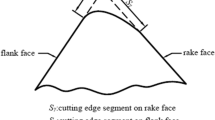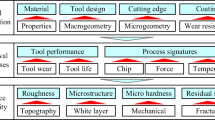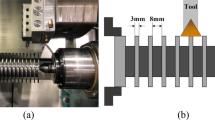Abstract
The cutting-edge radius plays a crucial role in precision machining. An optimally matched radius to the uncut chip thickness can significantly extend tool life. When the uncut chip thickness varies along the cutting edge, preparing the edge with individual radii at different positions is ideal. A novel non-uniform edge preparation approach based on magnetorheological finishing is proposed in this paper. The flexible abrasive tool formed by the magnetorheological effect is presented to prepare a controllable removal and low-damage cutting edge. In this study, the edge preparation device is designed and built, and the structure of the grinding basin is optimized. The magnetic induction intensity distribution in the grinding basin under the action of the external magnetic field is studied. Considering the influence of the magnetic induction intensity, the viscosity change rule of the magnetorheological fluid under different magnetic field intensities is discussed, and a flow field simulation model with variable viscosity is developed. Based on simulation and experiment, the cutting-edge material removal rate is analyzed, and the Preston coefficient is calculated. The results show that magnetorheological preparation can achieve non-uniform directional quantitative removal of edge materials. This study provides a new approach for preparing non-uniform tool edges, which has a positive significance in producing high-performance tools.












Similar content being viewed by others
Data availability
Data related to this work will be provided upon request.
Code availability
Part of the code can be provided upon request for noncommercial purpose.
References
Uysal A, Ozturk S, Altan E (2015) An experimental study on dead metal zone in orthogonal cutting with worn rounded-edge cutting tools. Int J Mater Prod Technol 51(4):401–412
Woon KS, Chaudhari A, Rahman M, Wan S, Kumar AS (2014) The effects of tool edge radius on drill deflection and hole misalignment in deep hole gun drilling of Inconel-718. CIRP Ann 63(1):125–128
Denkena B, Grove T, Maiss O (2015) Influence of the cutting edge radius on surface integrity in hard turning of roller bearing inner rings. Prod Eng Res Devel 9(3):299–305
Vopát T, Sahul M, Haršáni M, Vortel O, Zlámal T (2020) The tool life and coating-substrate adhesion of AlCrSiN-coated carbide cutting tools prepared by LARC with respect to the edge preparation and surface finishing. Micromachines 11(2):166
Zhao T, Agmell M, Persson J, Bushlya V, Ståhl JE, Zhou JM (2017) Correlation between edge radius of the cBN cutting tool and surface quality in hard turning. J Superhard Mater 39(4):251–258
Hariprasad B, Selvakumar SJ, Raj DS (2022) Effect of cutting edge radius on end milling Ti–6Al–4V under minimum quantity cooling lubrication–chip morphology and surface integrity study. Wear 498:204307
Jiang F, Guo B, Liao T, Wang FZ, Cheng X, Yan L, Xie H (2019) Optimizing the geometric parameters of cutting edge for the finishing machining of 30Cr alloy steel. Int J Comput Methods 16(08):1850117
An QL, Ming WW, Cai XJ, Chen M (2015) Effects of tool parameters on cutting force in orthogonal machining of T700/LT03A unidirectional carbon fiber reinforced polymer laminates. J Reinf Plast Compos 34(7):591–602
Bouzakis KD, Charalampous P, Kotsanis T, Skordaris G, Bouzakis E, Denkena B, Breidenstein B, Aurich JC, Zimmermann M, Herrmann T, M’saoubi R (2017) Effect of HM substrates’ cutting edge roundness manufactured by laser machining and micro-blasting on the coated tools’ cutting performance. CIRP J Manuf Sci Technol 18:188–197
Zimmermann M, Kirsch B, Kang YY, Herrmann T, Aurich JC (2020) Influence of the laser parameters on the cutting edge preparation and the performance of cemented carbide indexable inserts. J Manuf Process 58:845–856
Na Y, Lee US, Kim BH (2021) Experimental study on micro-grinding of ceramics for micro-structuring. Appl Sci 11(17):8119
Oliaei SNB, Karpat Y (2016) Investigating the influence of built-up edge on forces and surface roughness in micro scale orthogonal machining of titanium alloy Ti6Al4V. J Mater Process Technol 235:28–40
Krebs E, Wolf M, Biermann D, Tillmann W, Stangier D (2018) High-quality cutting edge preparation of micromilling tools using wet abrasive jet machining process. Prod Eng Res Devel 12(1):45–51
Wang WT, Biermann D, Aßmuth R, Arif AFM, Veldhuis SC (2020) Effects on tool performance of cutting edge prepared by pressurized air wet abrasive jet machining (PAWAJM). J Mater Process Technol 277:116456
Tiffe M, Aßmuth R, Saelzer J, Biermann D (2019) Investigation on cutting edge preparation and FEM assisted optimization of the cutting edge micro shape for machining of nickel-base alloy. Prod Eng Res Devel 13(3):459–467
Denkena B, de León L, Bassett E, Rehe M (2010) Cutting edge preparation by means of abrasive brushing. Key Eng Mater 438:1–7
Malkorra I, Souli H, Claudin C, Salvatore F, Arrazola P, Rech J, Seux H, Mathis A, Rolet J (2021) Identification of interaction mechanisms during drag finishing by means of an original macroscopic numerical model. Int J Mach Tools Manuf 168:103779
Lv D, Wang YG, Yu X, Chen H, Gao Y (2022) Analysis of abrasives on cutting edge preparation by drag finishing. Int J Adv Manuf Technol 119(5):3583–3594
Karpuschewski B, Byelyayev O, Maiboroda VS (2009) Magneto-abrasive machining for the mechanical preparation of high-speed steel twist drills. CIRP Ann 58(1):295–298
Endres WJ, Kountanya RK (2002) The effects of corner radius and edge radius on tool flank wear. J Manuf Process 4(2):89–96
Ducobu F, Rivière-Lorphèvre E, Filippi E (2017) Experimental and numerical investigation of the uncut chip thickness reduction in Ti6Al4V orthogonal cutting. Meccanica 52(7):1577–1592
Abdellaoui L, Khlifi H, Bouzid SW, Hamdi H (2020) Tool nose radius effects in turning process. Mach Sci Technol 25(1):1–30
Vipindas K, Anand KN, Mathew J (2018) Effect of cutting edge radius on micro end milling: force analysis, surface roughness, and chip formation. Int J Adv Manuf Technol 97(1):711–722
Yussefian NZ, Hosseini A, Hosseinkhani K, Kishawy HA (2017) Design for manufacturing of variable microgeometry cutting tools. J Manuf Sci Eng 140(1):011014
Özel T (2009) Computational modelling of 3D turning: influence of edge micro-geometry on forces, stresses, friction and tool wear in PcBN tooling. J Mater Process Technol 209(11):5167–5177
Karpat Y, Özel T, Sockman J, Shaffer W (2007) Design and analysis of variable micro-geometry tooling for machining using 3-D process simulations. In: Proceedings of International Conference on Smart Machining Systems
Peng XQ (2004) Research on key technologies of deterministic magnetorheological polishing. Dissertation, National University of Defense Technology
Song SQ, Lu B, Zuo DW, Zhou H, Zhen L, Zhou F (2020) A new cutting edge surface reconstruction method for hard whirling tools. Meas 151:107276
Peng XQ, Dai YF, Li SY (2004) Mathematical model of material removal in magnetorheological polishing. Chin J Mech Eng 40(4):67–70
Xu J (2015) Research on magnetorheological polishing process and polishing trajectory of small tool head. Dissertation, Harbin Institute of Technology
Funding
The study was funded by the National Natural Science Foundation of China (No.51605414), the Postgraduate Research and Practice Innovation Project of Yancheng Institute of Technology (SJCX21_XZ004, SJCX22_XZ017, SJCX22_XY034), and the Key Laboratory Fund Project of Zhejiang Provincial Key Laboratory for Cutting Tools (ZD202110).
Author information
Authors and Affiliations
Contributions
Xiangyu Guan: validation, investigation, writing—original draft; Donghai Zhao: investigation, writing—original draft; Yaxin Yu: data curation, software, validation; Dunwen Zuo: conceptualization, supervision; Shuquan Song: conceptualization, methodology, supervision, writing—original draft.
Corresponding author
Ethics declarations
Ethics approval
The manuscript has only been communicated to one journal only and has not been submitted to more than one journal for simultaneous consideration.
Consent to participate
The authors have given their consent to participate.
Consent for publication
The authors have given their consent to publish the present paper.
Conflict of interest
The authors declare no competing interests.
Additional information
Publisher's note
Springer Nature remains neutral with regard to jurisdictional claims in published maps and institutional affiliations.
Rights and permissions
Springer Nature or its licensor (e.g. a society or other partner) holds exclusive rights to this article under a publishing agreement with the author(s) or other rightsholder(s); author self-archiving of the accepted manuscript version of this article is solely governed by the terms of such publishing agreement and applicable law.
About this article
Cite this article
Guan, X., Zhao, D., Yu, Y. et al. Controllable preparation of non-uniform tool edges by magnetorheological finishing. Int J Adv Manuf Technol 125, 4119–4131 (2023). https://doi.org/10.1007/s00170-023-11019-7
Received:
Accepted:
Published:
Issue Date:
DOI: https://doi.org/10.1007/s00170-023-11019-7




